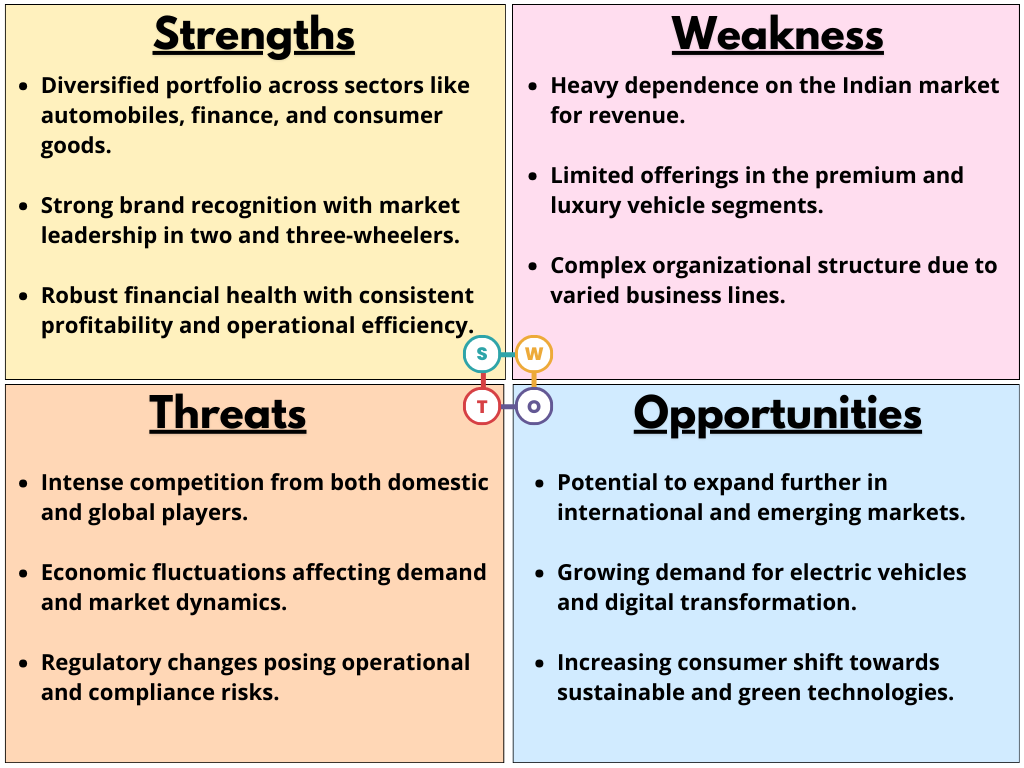In 2024, the Bajaj Group is a testament to almost 100 years of business excellence. It has grown from a small trading firm to a global powerhouse with a presence in industries like automotive, financial services, electrical, and insurance. The group comprises over 40 companies with a market capitalization of approximately ₹1,100 billion and employs more than 36,000 people worldwide.
Bajaj Auto remains a leader in two- and three-wheelers globally, while Bajaj Finserv is a significant player in financial services, including insurance and lending. Bajaj Electricals and Bajaj Allianz further expand the group’s reach into diverse industries, showcasing its strategy of balanced growth.
The group’s leadership has been key to its success, with multiple generations of the Bajaj family driving innovation. Rahul Bajaj, the iconic Chairman, transformed Bajaj into a global industrial powerhouse. Rajiv Bajaj, Managing Director of Bajaj Auto, has overseen its modernization and global expansion, while Niraj Bajaj has steered Mukand Ltd., the group’s steel and engineering company, towards steady growth.
This article takes a trip back through the history of Bajaj, exploring the factors behind its impressive journey and ongoing success.
In Search of a Purpose
Jamnalal Bajaj (1889-1942)purpose
The story of Bajaj begins with Jamnalal Bajaj, born in 1889 in Rajasthan. Though his early life was marked by poverty, he was adopted by a wealthy merchant family, where he gained experience in managing businesses. After inheriting the family’s wealth, Bajaj contributed financially to the British during World War I, for which he was awarded the title 'Rai Bahadur.'
As the treasurer of the Indian National Congress, Bajaj played a key role in raising ₹1 crore in 1921 for the All India Tilak Memorial Fund, primarily to support the Khadi movement. He also donated over ₹25 lakhs to various charities.
In addition to his political activities, Bajaj supported self-reliance, rural development, and efforts to combat untouchability. Under Gandhi’s guidance, he founded Hindusthan Sugar Mills Ltd., laying the groundwork for what would eventually grow into the Bajaj Group.
Two brothers, One vision-
Kamalnayan Bajaj (1915-1972) & Ramkrishna Bajaj (1923-1994)
After inheriting the business in 1942, the two brothers Kamalnayan and Ramkrishna Bajaj carried the family business into a sprawling conglomerate.
Kamalnayan diversified the group’s interests, moving into sectors like automobiles, electrical, cement, and steel. In 1938, he founded Radio Lamp Works Limited, which later became Bajaj Electricals Ltd. He also founded Bachraj Trading Corp. Pvt. Ltd. in 1945, which evolved into Bajaj Auto Ltd. By the time of his passing in 1972, the group had grown from₹1 crore in sales to₹76.24 crore, with a profit of₹8.41 crore.
Meanwhile, Ramkrishna helped establish the Jamnalal Bajaj Foundation, was a founding member of the Advertising Standards Council of India (ASCI), and served as president of organizations like the Federation of Indian Chambers of Commerce and Industry (FICCI).
Timeline of the Bajaj Group
1926: Jamnalal Bajaj founded the Bajaj Group in Mumbai, marking the beginning of its journey.
1931: The group diversified into sugar production by setting up its first sugar manufacturing unit. This marked its early steps into the industrial sector.
1945: Bajaj Electricals Limited was established, diversifying into electrical appliances.
1948: The group ventured into the steel industry by establishing Mukand Iron & Steel Works Limited. This diversification helped the group build a strong industrial base.
1959: Bajaj Auto was incorporated, signalling the group's entry into automobiles.
1961: The launch of the iconic Bajaj Chetak scooter, which became hugely popular and synonymous with affordable transportation.
1970: Expanded its automotive operations to include motorcycles. This helped the company capture a larger share of the two-wheeler market in India.
1998: Bajaj Finance Limited was established.
2008: Bajaj Auto was demerged into three independent entities: Bajaj Auto, Bajaj Finserv, and Bajaj Holdings & Investment Limited.
2010: The group expanded into insurance with Bajaj Allianz Life Insurance. This addition further diversified its financial services portfolio.
2015: Bajaj Electricals entered the LED lighting and smart home appliances market.
2017: Bajaj Auto became the world’s largest manufacturer of three-wheelers.
2019: Bajaj Finance Limited became a blue-chip stock on the Indian stock market.
2021: Bajaj Auto ventured into electric mobility with the re-introduction of the Chetak brand.
2023: Bajaj Auto announced a strategic partnership with global automotive companies to expand its international footprint.
2024: The Bajaj Group underwent a strategic reorganization to sharpen its focus on core business areas. This restructuring is aimed at driving innovation and integrating digital technologies for future growth.
Also Learn: Aditya Birla Group Tracing the Legacy and Global Expansion
Bajaj Group and its subsidiaries
Listed companies
As of September 2024, the group has 10 companies listed on the stock market. Here is a list:
| Company Name | Market
Capitalization* |
Year
Listed |
| Bajaj Finance Ltd. (BAJFINANCE) | ₹ 4,54,730 Cr. | 1994 |
| Bajaj Auto Ltd. (BAJAJ-AUTO) | ₹3,02,935 Cr. | 2008 |
| Bajaj Finserv Ltd. (BAJAJFINSV) | ₹ 2,96,867 Cr. | 2011 |
| Bajaj Holdings & Investment Ltd. (BAJAJHLDNG) | ₹ 1,16,870 Cr. | 1985 |
| Bajaj Electricals Ltd. (BAJAJELEC) | ₹ 11,394 Cr. | 1960 |
| Maharashtra Scooters Ltd. (MAHSCOOTER) | ₹ 11,341 Cr. | 1975 |
| Bajaj Hindusthan Sugar Ltd. (BAJAJHIND) | ₹ 4,980 Cr. | 1993 |
| Bajaj Consumer Care Ltd. (BAJAJCON) | ₹ 3,787 Cr. | 2009 |
| Mukand Ltd. (MUKANDLTD) | ₹ 2,207 Cr. | 1989 |
| Hercules Hoists Ltd. (HERCULES) | ₹ 1,830 Cr. | 1975 |
*Data as of 9th September 2024
Global expansions
The evolution of Bajaj Auto reflects just how much the company has grown over the years, yet one constant has remained—the signature blue Bajaj branding. Founded in 1945 as Bachraj Trading Corp. Pvt. Ltd., Bajaj initially imported scooters and rickshaws for the Indian market. However, the ambition to start local manufacturing led to a series of strategic partnerships with internationally recognized brands. These collaborations enabled Bajaj to integrate advanced technology and expertise into its operations, laying the foundation for its dominance in the automotive industry.
License Agreement with Piaggio (1960s):
Eager to capitalize on the growing demand for scooters, Bajaj formed a licensing agreement with Italian scooter manufacturer Piaggio to produce the Vespa 150cc scooter locally. This partnership helped Bajaj gain a foothold in the Indian market. When the agreement expired in 1970, Bajaj continued manufacturing scooters under its own brand name, introducing the legendary "Chetak." Other models like the Bajaj Super, Bajaj 150, and Bajaj Priya followed, with all selling in the millions.
Technical Partnership with Kawasaki (1984):
Bajaj, now a public company, collaborated with Kawasaki, one of Japan’s Big Four motorcycle manufacturers. This technical partnership allowed Bajaj to produce models like the Caliber and Boxer, both of which were incredibly successful. The partnership continued until its amicable dissolution in 2016–17.
Strategic Partnership with KTM (2007):
In 2007, Bajaj purchased a 14.5% stake in KTM, the Austrian performance bike manufacturer, which was facing financial difficulties at the time. This partnership introduced India to the KTM Duke, RC, and Adventure series—bikes known for their cutting-edge design and performance. Over time, Bajaj increased its stake to 49.9% in KTM’s parent company, further strengthening this alliance.
Extended Partnership with Husqvarna (2020):
Through KTM, Bajaj also formed a partnership with Husqvarna, the Swedish motorbike manufacturer known for its neo-retro Scrambler motorcycles. In 2020, Bajaj began manufacturing the Vitpilen 250 and Svartpilen 250 in India, broadening its portfolio and catering to a niche segment of biking enthusiasts.
Co-development Partnership with Triumph (2023):
Bajaj expanded its premium segment offerings through a co-development partnership with British bike manufacturer Triumph in 2023. Together, they launched the Speed 400 and Scrambler 400, mid-capacity motorcycles built in India for both domestic and international markets. This collaboration enabled Triumph to enter emerging markets and gave Bajaj access to a wider range of premium products.
Bajaj Auto's journey from importing scooters to becoming a major player in the global two- and three-wheeler industry is a testament to its strategic adaptability and focus on innovation. The launch of the Pulsar series was a particularly that transformative moment.
SWOT analysis
A Legacy of Innovation
Bajaj’s journey from a small trading company to a global conglomerate is a story of strategic diversification and resilience. From automobiles to financial services, the group’s commitment to innovation has ensured its continued growth.
The Bajaj Group's adaptability to market changes, global expansion, and leadership across industries make it a true Indian icon. Its ongoing legacy of excellence continues to inspire, and its future looks as promising as its rich history.
Also Read: Effects of the 2024 Iran-Israel War on the Indian Stock Market







